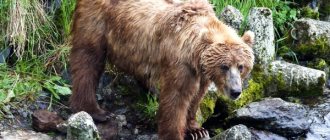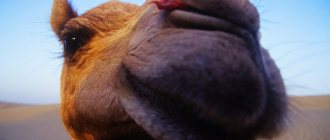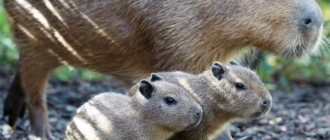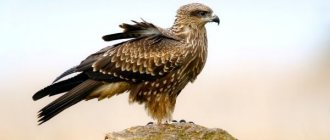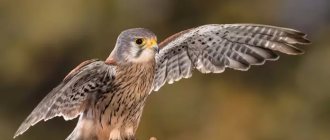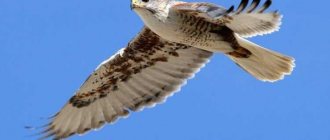Long eared owl
A bright representative of the owl family. Its main feature is its “ears” - large tufts of feathers located on the head, which the owl knows how to hide. The bird's body length is 31-37 cm, wingspan is 86-98 cm. The sizes of males and females of the long-eared owl are almost the same. This bird's eyes are large and orange. The paws are covered with light red feathers almost down to the claws. The claws themselves are long and sharp, with their help the long-eared owl grabs prey - various small rodents like voles or mice, and occasionally it comes across small birds or insects.
Western short-eared owl
Habitat: Southeast Alaska to western Canada and western US to central Mexico
These owls purposefully bring small, blind snakes, similar to large earthworms, into the nest to protect it from insects. Since owls usually prey on dead rodents, the smell of their bodies can attract a large number of insects to the nest, which the snakes feed on.
White Owl
A large bird from the order of owls, which is also called the polar owl. Its body length is 55-70 cm, weight - 900-3000 g, wingspan - 150-160 cm. One of the features of this species is that females are larger than males. The small head of a white owl, thanks to the special structure of the cervical vertebrae, can rotate 270 degrees. This bird nests on the islands of the Arctic Ocean and in the tundra. It is considered a very active predator. When getting ready to hunt, an owl sits on a hill, looks out for prey and then pounces on it, killing it with its beak and sharp claws. She easily catches up with other birds, as well as the fleet-footed tundra hare. The easiest prey for a snowy owl is lemmings.
Scientists have discovered how and why American ground owls eavesdrop on conversations between their rodent neighbors.
In this example, the eavesdroppers and the eavesdroppers belong to different classes of the animal world.
“Why aren’t the forests strewn with carcasses of owls?”
How do owls manage to turn their heads almost 270 degrees in both directions without any damage to their health...
04 February 18:11
Rabbit owls are owls that live in the open spaces of both American continents. These owls usually settle in burrows, and not always their own.
The term “keystone species” was once coined for prairie dogs, the plump rodents of the squirrel family. These marmot-like animals live in North America. They are a keystone species for the American West: their networks of extensive underground cities can cover vast areas and provide refuge for other animals. One of these invaders are rabbit owls, which often settle on the outskirts of dog settlements.
However, owls are not limited to seizing their neighbors' homes, but also eavesdropping on their conversations for their own benefit, scientists led by Rebecca Brown, a biologist at the University of Colorado, found. The results of their observations are described in an article published in the journal Ethology
.
It turned out that by listening to the roll call of dogs, which, as scientists recently found out, have a very complex language with the rudiments of grammar, owls learn about the approach of dangerous predators.
“We wanted to see if the owls were getting something else from their neighborhood, such as eavesdropping on the dogs,” Brown said.
Rock quieter than a mouse
The loudest screams heard in the air above our planet are the screams of bats. How…
30 April 16:59
To record the alarm calls of rodents, biologists took a toy rubber snake and dragged it through a colony of animals by a string.
Seeing the danger, the dogs made sharp sounds, which obviously meant “snake,” and attacked the newcomer.
“Now my rubber snake is missing about six inches of its tail,” the biologist said.
To find out whether owls responded to their neighbors' calls, the scientists played three types of sounds nearby—recorded snake warning calls from dogs, the sound of a low-flying airplane, and mooing cows.
It turned out that cries about a snake cause the most acute reaction in owls: they press themselves to the ground, tremble and rotate their heads much more actively than with the other two sounds.
Although scientists are not aware of cases of snake attacks on owls, it is reliably known that snakes encroach on their eggs and therefore pose a threat to nests.
Owls know who to listen to: Scientists have found that prairie dogs have one of the most complex languages of communication in the animal kingdom. Recent research has shown that blenny's language includes nouns, adjectives, verbs and even adverbs that they use to describe the size, shape, color and speed of dangerous predators.
Even the warning about a tall man in a blue T-shirt and a short man in a gray T-shirt sounds different to them.
Singing hamsters will help stutterers
If we understand which genes unique South American rodents use in their trills, we may be able to...
08 September 11:26
“Previously, scientists were embarrassed to call it a language because they did not have enough data. However, it recently became clear that this is indeed the case,” explained Con Slobodchikov, a biologist at the University of Arizona in Flagstaff who studied the calls of prairie dogs and ate the dog.
The presence of a wide range of sounds is necessary for dogs in their daily struggle for survival in the face of danger from various predators. When a hawk approaches, the best solution is to hide in a hole, but when they hear a signal about a snake, the animals stand on their hind legs and monitor the surrounding area.
Scientists believe that their discovery once again showed the complex relationship between neighboring animals that use each other's signals. “Mammals eavesdrop on birds, birds eavesdrop on mammals—it’s a whole network where everyone is tuned in to everyone else’s cries of danger,” says Kenneth Schmidt, an ecologist at the University of Texas at Lubbock.
“For a long time, we underestimated the abilities of animals, perceiving them as small robots acting according to their own programs,” says biologist Slobodchikov. “However, in reality they are much more developed and intelligent than we thought about them.” With this in mind, animals deserve more respect.”
Great-footed owl
This small short-tailed owl is found in dense northern forests. The bird got its name because its legs are covered with feathers. The body length of the owl is 23-27 cm. Weight is 120-190 g. The bird leads a sedentary lifestyle, hides in dense thickets and almost never flies out into the open. Thorn owls feed on small animals, birds and insects, hunting them at night. They nest in old hollows.
Rabbit owl
The rabbit owl is a small bird from the owl family, which has the most atypical habits for owls. It can chase its prey underground, and digs holes as a home, which is why it received its unusual species name. Due to such a specific lifestyle, this bird is also known as the rabbit or cave owl, and due to its typical distribution area it is often called the American ground owl.
Habitats
Unlike other owls, which have a wider distribution area around the world, the rabbit owl is a typical inhabitant of the two American continents, and in North America it is more common. It is found exclusively in open spaces, mainly in the northwestern states of the USA, in Central America and in the south of the South American continent near Cape Horn, which is not very hospitable for sailors.
There are rare populations of these owls on a number of small islands in the Caribbean. Depending on their habitat, there are 21 species of rabbit owls.
Pastures and farmlands, grass fields and desert areas with low vegetation are the main places where this species of owl lives. It is in such terrain that there is a chance of stumbling upon the burrows of the rabbit owl, in which he lives and rests in the heat. It is not found in forests and places with dense bushes.
Rabbit owls can create burrows themselves, using their claws and sharp beak. But more often they prefer to occupy the abandoned homes of prairie dogs. Such underground “apartments” can be located at a depth of up to 1 m from the ground and have several branched corridors ranging from 1 to 3 meters in length. Interestingly, due to their long life underground, rabbit owls are distinguished by their ability to remain under the influence of carbon monoxide for a long time without consequences for their health.
Appearance
In color, the rabbit owl is slightly reminiscent of the little owl, but the main difference is its long legs. Its plumage is gray-brown with oblong and rounded white patches. White spots predominate on the chest, while the lower abdomen is light yellow without spots, and there are light spots on the back.
In some species of rabbit owls, the color of the plumage can be determined by their habitat and vary from brown to chocolate, and to sandy color in those species that live in deserts. Females have the darkest plumage, while juveniles have the lightest plumage.
The head of rabbit owls is rounded, there are no feather “ears”, and the facial disc is a light cream color. Their legs are long and their tail is very short. These owls have a gray-green beak and bright yellow eyes. Rabbit owls can comically crane their necks to explore their surroundings.
Their body length does not exceed 23-26 cm, but their wingspan reaches 50 cm and, curiously, during flight their flapping movements can be asynchronous. The weight of a rabbit owl can reach 170-210 grams, while females are always smaller (although for most owls it is just the opposite). The largest individuals live in the Andes.
Lifestyle
These birds are similar to rabbits not only because they live in burrows, but also because they live in small colonies. In places where rabbit owls live, you can see whole flocks of these funny long-legged birds. In case of danger, they drive away the enemy with the whole friendly flock. Cave owls are sedentary, with the exception of those that live in the northern regions and migrate annually to Texas for the winter.
Unlike other owls, the rabbit owl is especially active during the day, but not during the midday heat, from which it always seeks to hide in its hole, for which it is also called a hiding owl. But it still hunts more often at dusk, but night hunting is not typical for it, unlike most species of owls. Despite a number of differences and an atypical lifestyle, these birds are still considered a species of owl, since DNA analysis has confirmed their relationship.
Food and hunting
In terms of obtaining food, these owls show remarkable cunning, collecting the excrement of various mammals and dragging them into their burrows in order to attract dung beetles and other insects, which become the main food of these small birds. They also leave droppings of other animals at the entrance to their home in order to deceive predators. These birds scare away their potential enemies by emitting a hiss characteristic of a rattlesnake, and by tilting their heads in a funny way, they simply listen and determine the location of the prey or the likely danger to themselves.
The characteristic prey of rabbit owls is largely determined by their habitat, but mainly these are various insects. Beetles, crickets and grasshoppers, butterflies and spiders, and even scorpions form the main food for these small birds of prey from the owl family.
But sometimes rabbit owls can hunt small lizards, small rodents and birds. Also, unlike a number of other owls, they can feed on plant foods, in particular, seeds and fruits of various plants, including cacti. These owls always have a supply of food for future use in their burrow.
Like other owls, they can roam the ground and catch insects living in the soil, or easily catch up with spotted prey on their long, high legs. They can also look out for potential prey during the flight, and in terms of the speed of their dive to the ground, when it is spotted, they are not inferior to any other owl.
Breeding offspring
Rabbit owls, even in terms of breeding offspring, differ from their other relatives. It is common for them to create monogamous families, but at the same time, the males of these owls are sometimes characterized by “bigamy” (as a rule, they have 2 permanent partners). Unlike all other owls and owls, they settle in colonies, in which there can be up to 12 pairs. But during the mating season, males can fiercely guard exclusively personal “hunting grounds”, the area of which can be 2-3 square meters. km.
The mating season for these birds falls in March-April. Male rabbit owls here are also distinguished by unique “games”, the spectacle of which is designed to attract females and is absolutely not typical for any owls. They emit inviting hooting “trills”, after which they fly up 25-30 m above the ground, circle at this height for up to 5-10 seconds and then rapidly descend to 10-15 m and fly up again. They can repeat this mating ritual many times.
In preparation for having offspring, these birds cover the nest inside the burrow with dry grass and down. One couple can use their underground “house” for several years. The female rabbit owl is highly fertile and can lay from 6 to 12 eggs (usually only half of the chicks survive), which they incubate for a month.
At this time, the male provides her with food, but the offspring that are born are already fed by both parents. 2 weeks after birth, the babies are already crawling to the exit of the hole, where they are waiting for their breadwinners with the food they have obtained. Subsequently, the father of the family teaches the chicks to hunt. After another 1.5 months, they leave their home and begin to get their own food by hunting insects. If the young birds do not die within a year, then next spring they will be able to breed their own offspring.
Their main enemies are falcons among birds, badgers, armadillos and skunks among land animals, as well as various poisonous snakes. Typically, the lifespan of rabbit owls in the wild reaches 8-9 years. Although their population is extensive, in some regions of the United States, Mexico and Canada their numbers are very small and are constantly decreasing.
Sychik-elf
This is a tiny owl, 12-14 cm long. It has a relatively large head, but a weak beak and not very developed legs, which makes hunting difficult. Therefore, the elf owl feeds mainly on small insects. It lives in desert areas of the southern United States and Mexico. Its distribution is closely related to the giant saguaro cacti. The owl nests in the hollows of these plants, most often hollowed out by woodpeckers. Sometimes he lives with woodpeckers or other small owls.
Cave owl
Sometimes this bird is also called the rabbit owl. It lives in southern North America. The cave owl has long fingers covered with bristles, wide wings, and a short tail. The total length of its body is about 20 cm. This owl is found both on the plains and in the mountains. For example, in the Andes, cave owls live at an altitude of 3000-4000 m. They nest in burrows, natural or dug by other animals, sometimes they dig burrows themselves. Cave owls feed mainly on insects, but also on small mammals - various rodents, and less often - reptiles and small birds.
insect storm
The Elf Owl feeds on grasshoppers, locusts, moths, fly larvae, caterpillars, scorpions and spiders. If the scorpion is intended for a chick, the parent first carefully removes the sting and then feeds the arthropod to the baby. Elf owls hunt at dawn, dusk and dusk. They are very maneuverable in flight, so they prefer to hunt on the fly. The feathers of elf owls are arranged differently from those of other owls, and do not allow them to fly silently, but they do not need this. They scare insects, causing them to fly, and then peck them. From time to time, owls hunt on the ground, pecking insects from trees or the ground. Birds will sometimes fly towards campfires or other bright lights in search of flying insects. Before eating prey, owls carry it to a shelter, where they tear it into pieces and then eat it.
Western armyworm
Habitat: in the summer in southwestern Canada, throughout the western United States, and in Mexico, where they fly to winter
The name of this species is "psiloscops flammeolus", and is translated from Latin as "fiery orange", which is a description of their unique coloration. The cutworm loves to hunt nocturnal insects and spiders, which it catches in the air or among the foliage.
Great Gray Owl
It is a long-tailed and long-winged bird. The total length of its body is 63-66 cm, its wingspan is 130-140 cm, its weight is 700-1200 g. The great gray owl mainly uses the old nests of other birds, but sometimes it builds its own nest, more often placing it on the tops of broken trees, high above the ground. It feeds on rodents, small mammals, and medium-sized birds.
Diet of owls
Owls feed mainly on live prey. Their favorite food consists of small mammals such as mice, voles, shrews, rats, lemmings, rabbits, and mountain hares. Owls also love earthworms, various insects, small snakes and other reptiles. In addition, they will not refuse fish and crustaceans. Owls often attack other birds and even smaller birds. A large owl on the hunt can kill a young fawn. These birds can live for months without water, quenching their thirst with the blood of their victims. But they don’t behave this way unless absolutely necessary—they need water not only for drinking, but also for bathing.
Share link
